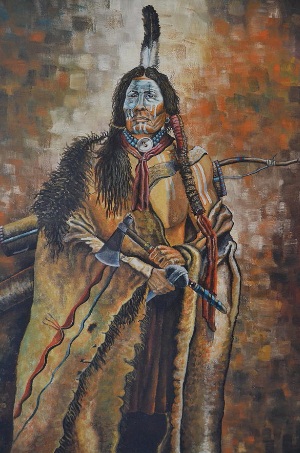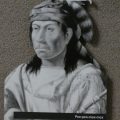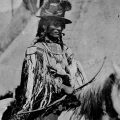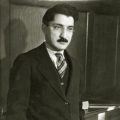While the Algonquian-speaking Cheyenne are generally considered a Plains Indian tribe, they actually moved onto the Plains from what is now Minnesota. As a result of this migration, the Cheyennes evolved from a farming people to a horse-mounted buffalo-hunting people. By the mid-nineteenth century, Cheyenne warriors were often engaging the United States military in a series of skirmishes or battles. One of the prominent warriors at this time was known to the Americans as Roman Nose.
Roman Nose, whose Cheyenne name was Woquini (also spelled Waquini and Wokini) meaning “Hook Nose” or “Arched Nose,” was born about 1830 (1835 in some sources). Almost nothing is known today about his early life. He entered into American history during the Indians wars of the 1860s, capturing the attention of non-Indian historians and the media with his war exploits. In his biographic sketch of Roman Nose in Notable Native Americans, Steven Conliff writes:
“Roman Nose’s bold tactics and seemingly impenetrable demeanor made him something of a legend in the Native American conflicts with white settlers; he became a virtual epic hero, riding on horseback, his flowing feathered medicine hat topped by a lone buffalo horn, which in battle resembled an eagle’s beak.”
In their biography of Roman Nose in the Encyclopedia of North American Indians, John Moore and Shelley Arlen write:
“One of the esteemed warriors of the Great Plains, Roman Nose fit the white man’s romantic notion of an ideal Indian warrior, and his story highlights both the tragic clash of cultures on the plains and the ignorance and misunderstanding with which white observers approached the ‘Indian problem.’”

In his book Who Was Who in Native American History: Indians and Non-Indians From Early Contacts Through 1900, Carl Waldman writes:
“Whites of his time credited him with leading the Cheyennes in more battles than he actually fought.”
Since Roman Nose was a well-known warrior among the American military, engaging him in battle was considered prestigious and, thus, many military leaders reported that they had fought against Indians led by the famous Roman Nose.
While Roman Nose was a prominent warrior and war leader, he was not a chief in that he was not a member of the Council of 44. The Council of 44 was the most formal political structure among Plains Indian nations. This Council was traditionally made up of four peace chiefs elected from each of the ten Cheyenne bands. In his book The Cheyenne Indians: Their History and Lifeways (originally written in 1923), George Bird Grinnell reports that Roman Nose had been selected to serve on the Council, but had refused the honor.
It was typical for Plains Indians warriors to have a special war medicine—a decorated shield, a special paint, an amulet, etc.—which would protect them in battle. For Roman Nose, his war medicine was a special war bonnet which featured a single buffalo horn and a long tail of red and black eagle feathers. Steven Conliff writes:
“In battle Roman Nose would always strike first and draw enemy fire. He had an unflinching faith in the protective power of the war bonnet given to him by an old medicine man named White Bull. Roman Nose believed that as long as he wore the bonnet and adhered to a strict set of rules of conduct, he would possess a hypnotic power over his enemies and be immune to bullets.”
In his Encyclopedia of American Indian Wars, 1492-1890, Jerry Keenan writes:
“Roman Nose was especially sensitive to the observance of religious taboos prior to battle. He always went into battle wearing a special headdress that was believed to hold certain powers. Roman Nose was always careful to avoid eating anything touched by metal prior to a battle.”
With regard to the war medicine of his headdress, if food had been pierced with metal and eaten prior to battle, then a metal bullet would be able to pierce the flesh.
With regard to one of the taboos associated with the headdress, George Bird Grinnell reports that White Bull, in giving the headdress to Roman Nose, warned him:
“After I finish this and you put in on your head, you must never shake hands with anyone. If you do so, you will certainly be killed.”
The protective powers of Roman Nose’s headdress required specific rituals prior to battle in order for it to work. John Moore and Shelley Arlen report:
“It was not unusual for him to arrive at a battle site after the skirmish had begun, because a long and complicated ceremony had to be performed before he could put on his headdress.”
The strategy used by the U.S. military against Indians deemed unfriendly (usually any group not on a reservation) focused on destroying villages and food supplies (destroying crops, stored foods, and exterminating the buffalo). In response, Indian war parties turned to raiding non-Indian homesteads and killing cattle for food.
It was following the 1864 Sand Creek Massacre that Roman Nose first appeared in the military accounts of encounters with Indians. Briefly described below are some of the events in which Roman Nose was involved.
The Battle of Platte Bridge
The Platte Bridge Station located near present-day Casper, Wyoming, had a garrison of Civil War volunteers from Kansas and Ohio. The station was protected by a wooden stockade. In 1865, some 3,000 Cheyenne and Sioux warriors gathered to attack the Platte Bridge Station. The Cheyenne warriors were led by Dull Knife, White Bull, and Roman Nose. The Sioux warriors were led by Old Man Afraid of His Horses, Young Man Afraid of His Horses, and Red Cloud.
A small group of warriors acted as decoys and a detachment of soldiers was sent out to drive them off. Before the ambush trap could be closed, however, the soldiers were ordered back and returned without loss. The following morning 25 soldiers were sent out to escort a military wagon train back to the fort. They were attacked, and four soldiers killed. The war party then attacked the wagon train, killing over 20 soldiers. At least seven Cheyenne warriors were killed.
This battle marked the beginning of the War for the Bozeman Trail. Jerry Keenan writes:
“The fight at Platte Bridge was a harbinger of things to come on the northern Plains during the next three decades.”
Sometime after this battle, Roman Nose joined with Bull Bear, Tall Bull, and White Horse, the leaders of the Southern Cheyenne Dog Soldiers military society. During the middle of the nineteenth century, the Cheyenne Dog Soldiers (Dog Men) emerged as an elite fighting force. Historian John McDermott, in his book Circle of Fire: the Indian War of 1865, reports:
“The elite of the elite, they were a military society that evolved into a separate tribal unit. They took orders from their own military chiefs, not band leaders, and often lived apart.”
The Roman Nose Fight
In 1865, the 12th Missouri Cavalry and the 2nd Missouri Light Artillery entered the Powder River Country in Wyoming from Nebraska to wage war against the Sioux, Cheyenne, and Arapaho. The cavalry was armed with Spencer repeating carbines which had an effective range of 900 yards. Camped in the area, but unknown to the army, were 1,000 Sioux and Cheyenne lodges with 6,000 people. The Sioux and Cheyenne scouts, however, quickly discovered the troops and soon started skirmishes.
After several encounters with Indian war parties in which the army had the advantage of superior fire power, the army decided to turn back and head for Fort Laramie. For several days a running battle was fought with Cheyenne warriors armed with bows, lances, and a few trade guns. Roman Nose, riding a white war horse, rode in front of the troops, demonstrating his bravery and prowess. While his horse was hit, Roman Nose escaped injury and the fight became known as “Roman Nose’s Fight.”
Fort Larned Council
In 1867, General William T. Sherman began a campaign to drive all Indians out of a broad area of Kansas so that the Union Pacific Eastern Division (UPED) Railroad could be built. Small Indian war parties were attacking railroad survey parties and work crews and the Kansas newspapers were filled with accounts of Indian depredations. Some hysterical reports claimed that there were 78,000 warriors on the war path. Some newspapers called for a new government policy to exterminate the Indians.
To allow for the unimpeded construction of the railroad and to bring peace to the region, General Winfield Scott Hancock set out with a large force to hold council with the Cheyennes and to warn them of the consequences of their continued raids. Military historian Noah Trudeau, in an article in MHQ: The Quarterly Journal of Military History, reports:
“He marched forth hoping that a simple show of strength would intimidate the tribes he encountered and discourage them from raiding. The expedition would come to epitomize the kind of blind, arrogant soldiering that would so frequently fail against the Indians.”
In the initial meeting with the Cheyennes, General Hancock was annoyed that Roman Nose was not a member of the Cheyenne peace delegation. Writer Jerry Keenan, in an article in Wild West, reports:
“Refusing to accept the explanation that Roman Nose was not a chief and therefore not entitled to sit in on any kind of council, Hancock announced his intention to continue his march to the Indian village, which he had learned was located on Pawnee Fork or Red Arm Creek, about 35 miles west of Fort Larned.”
Here a group of Cheyenne warriors including Roman Nose rode out under a white flag to talk with the Americans. Harsh words were exchanged between Hancock and Roman Nose. Hancock broke off the peace talks and moved his soldiers closer to the village. The Americans attacked the Cheyenne village of 250 lodges the next day. Fearing a massacre like Sand Creek, the Indians fled. In retaliation, however, the Indians stopped almost all travel in western Kansas and progress on the railroad was halted.
The Battle of Beecher Island: Death of Roman Nose
In 1868, General Sheridan ordered the creation of a special company to track down and kill any Indians sighted along the path of the Kansas Pacific Railroad. Indians, according to General Sheridan, were a stone-age barrier to the advance of Christian civilization. According to historian Paul Andrew Hutton, in an essay in The Great Sioux War 1876-1877:
“He viewed all Indians as members of an inferior race embracing a primitive culture. He felt them to be inordinately barbarous in war, which he attributed to a natural, ingrained savageness of the race.”
Major George Forsythe, a Civil War veteran,organized the special company of civilian scouts. In his Encyclopedia of American Indian Wars, 1492-1890, Jerry Keenan reports:
“Most, though not all, were experienced frontiersmen, and some were veterans of the Civil War. Each man was armed with a 7-shot Spencer breech-loading carbine and a Colt revolver.”
In eastern Colorado, Sioux, Arapaho and Cheyenne warriors surrounded Major George A. Forsyth and his “first class frontiersmen.” Most of the special unit retreated to a smallsandbar (later called Beecher’s Island) where they dug rifle pits in the sand and had the protection of high grass and willows. Military historian Noah Trudeau reports:
“Several mass rushes by the Indians were beaten back with the help of the seven-shot spencers, though at a steep cost.”
With regard to the Indian weapons, John Moore and Shelley Arlen write:
“Aside from a few heavy carbines and old Sharps rifles, most of the Indians were armed only with bows and lances. The open prairie at streamside offered no shelter.”
Roman Nose arrived at the battle late. His war medicine had been contaminated by a Sioux woman who unknowingly fixed fried bread for him in a metal skillet and had removed it with a metal fork (his war medicine required that he avoid food that had touched metal when going into battle). Knowing that he would be killed, he rode to the front of the line and was shot in the small of the back. He died in the Cheyenne camp that night. Along with other warriors who had been killed in the battle, his body was placed on a scaffold, exposed to the sky and the wind. Later, American troops pulled the scaffolds down, leaving the bodies on the ground.
The siege lasted 8 days. The battle is known by the Americans as the “Battle of Beecher’s Island” (Lieutenant Frederick Beecher, second in command of the American forces, was killed in the fight) and by the Indians as “The Fight when Roman Nose was Killed.”
Major Forsyth estimated that the size of the Indian war party at 750 and claims that the Americans killed 32 (they actually killed 9).
In an essay reprinted in Eyewitnesses to the Indian Wars, 1865-1890: Volume Three: Conquering the Southern Plains, Major George Forsyth, writing in 1895, described Roman Nose in the battle:
“He was a man over six feet and three inches in height, beautifully formed, and save for a crimson silk sash knotted around his waist and his moccasins on his feet, perfectly naked. His face was hideously painted in alternate lines of red and black, and his head crowned with a magnificent war bonnet, from which, just above his temples and curving slightly forward, stood up two short, black buffalo horns, while its ample length of eagles’ feathers and herons’ plumes trailed wildly on the wind behind him; and as he came swiftly on at the head of his charging warriors, in all his barbaric strength and grandeur, he proudly rode that day, the most perfect type of savage warrior it has been my lot to see.”
One of the army scouts, Fletcher Vilott, in an essay reprinted in Eyewitnesses to the Indian Wars, 1865-1890: Volume Three: Conquering the Southern Plains, described Roman Nose:
“Save a gorgeous war bonnet covering his temples and a narrow sash about his loins, he is nude; his left arm wears a shield, while his right hand grasps a heavy revolver.”
Family
Roman Nose is known to have had two wives: Island, with whom he had a daughter called Crooked Nose Woman, and Woman with White Child, with whom he also had a daughter (no name indicated in the sources).
Indians 101
Indians 101 is a series exploring American Indian biographies, histories, cultures, and current concerns. More biographies from this series:
Indians 101: Joseph LaFlesche, Omaha Chief
Indians 101: Looking Glass, Nez Perce Chief
Indians 101: Ilchee, a Powerful Chinook Woman
Indians 101: Nakaidoklini, Apache Spiritual Leader
Indians 101: Eschiti, Comanche Medicineman




Leave a Reply